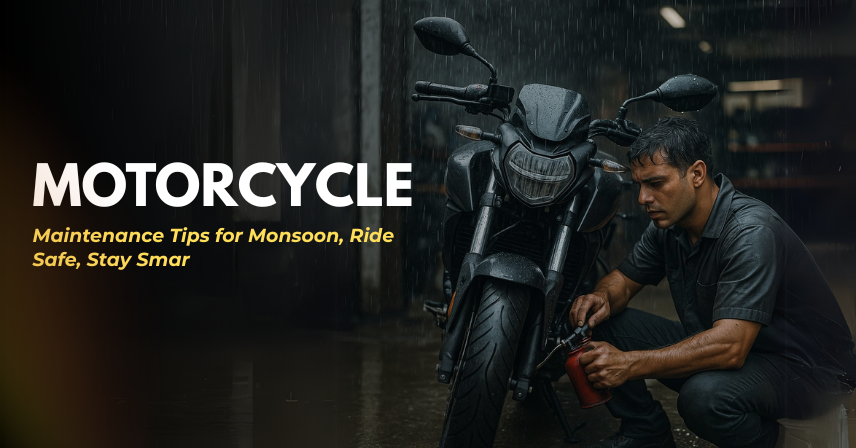Ride Safe, Stay Smart
Monsoon brings the much-needed relief from scorching heat, but for motorcyclists, it also introduces a unique set of challenges. From slippery roads to water-drenched engines, the rainy season can be tough on two-wheelers. If you’re a rider, keeping your motorcycle in top shape during this season isn’t just about performance—it’s about safety too. In this blog, we’ll explore practical and essential motorcycle maintenance tips for the monsoon, ensuring your bike stays reliable and your rides remain worry-free.
Why Monsoon Motorcycle Maintenance Matters
Rain, humidity, and muddy roads can severely affect your motorcycle’s electrical systems, brakes, tires, and even bodywork. Without timely care:
- Your brakes may fail or become less responsive.
- Rust can settle into metal components.
- Water ingress may damage the battery or engine parts.
- Tires can lose grip, risking accidents.
Proactive maintenance not only extends your bike’s lifespan but also helps prevent expensive repairs and enhances your riding confidence during the rains.
1. Start with a Thorough Pre-Monsoon Check
Before the rains set in, do a complete health check-up of your motorcycle. Look out for:
- Loose bolts, worn-out cables, or exposed wires
- Old brake pads or low brake fluid
- Dry chains or rusted components
- Weak battery or poor ignition
If you’re not confident doing this yourself, visit an authorized service center for a monsoon check- up package.
2. Protect Your Motorcycle with Anti-Rust Coating
Humidity and rain promote corrosion. Apply anti-rust spray or WD-40 to vulnerable areas like:
- Nuts and bolts
- Chain and sprockets
- Footrests, handlebar joints, and side stands
Also, consider applying a Teflon coating or ceramic wax to painted parts. It acts as a shield against water, mud, and grime.
3. Check Tyre Condition & Tread Depth
Tyres are your only contact with the road—make sure they’re monsoon-ready.
- Ensure tread depth is above 2-3 mm for effective grip.
- Avoid worn-out or cracked tyres.
- Maintain manufacturer-recommended tyre pressure—overinflation can reduce grip onwet surfaces.
You can also opt for rain-specific or dual-purpose tyres for better traction in wet conditions.
4. Inspect and Maintain the Braking System
Wet brakes reduce stopping power. Here’s how to keep them reliable:
- Clean brake pads and discs regularly to remove mud or debris.
- If your bike has drum brakes, check the internal linings for wear.
- Ensure brake fluid levels are sufficient and top up if needed.
Don’t delay brake pad replacement if they feel soft or squishy during rain rides.
5. Lubricate Chain Regularly
Rain washes away lubrication, leaving your chain dry and exposed to rust. To maintain chain health:
- Clean the chain using a soft brush and mild degreaser.
- Reapply chain lube or grease every 300-400 km or after every heavy rain.
- Use a chain cleaner and lube combo for better results.
A dry chain increases friction and reduces performance, while a well-lubricated one ensures smooth rides.
6. Keep Electricals Safe and Dry
Water can seep into your electrical circuits, causing short circuits or ignition failure.
- Cover the battery terminals and use petroleum jelly to avoid rust.
- Check wiring harnesses for exposed or cracked insulation.
- Use dielectric grease on connectors to prevent water entry.
- Avoid washing your bike using high-pressure jets during rains.
Keep a spare fuse and spark plug handy for emergencies.
7. Upgrade to Waterproof Accessories
If you’re commuting daily in the rain, invest in:
- Waterproof bike covers to protect the body and engine.
- Handlebar grips with rubber coatings for better control.
- Mud flaps and chain guards to prevent water splash.
- Waterproof tank bags or saddle bags for safe storage.
Choose anti-fog visors or apply a water-repellent spray for clear vision during rides.
8. Ensure Headlamps and Indicators Are Working
Visibility during monsoon is often poor, so lights become critical.
- Clean the headlamp lens and check bulb brightness.
- Replace any flickering or dim indicators.
- Use LEDs for better visibility and energy efficiency.
Ensure the tail lamp and brake light are clearly visible from a distance.
9. Check Air Filter Regularly
During the monsoon, dust and moisture can choke the air filter, reducing performance.
- Clean or replace the air filter every 1000–1500 km.
- Use a dry cloth or compressed air to remove sludge and grime.
- Avoid water entering the air filter box by keeping it tightly sealed.
If you ride through water-logged areas, inspect it more frequently.
10. Clean Your Motorcycle Post Ride
Muck and grime stick to the bike’s underbody, suspension, and wheels.
- Use a low-pressure water rinse to remove slush.
- Wipe the motorcycle dry using a microfiber cloth.
- Apply a quick coat of spray polish to prevent watermarks and rust.
Never leave your bike wet overnight—moisture buildup is the enemy.
11. Use Fuel Additives if Needed
Excess water in the air can result in fuel tank condensation.
- Keep the tank full to reduce air volume inside.
- Use fuel additives or octane boosters occasionally to prevent moisture-related issues in the fuel line.
- Clean the carburetor/injector once the season ends for optimal performance.
12. Ride Cautiously & Be Prepared
Even with perfect maintenance, riding in rain demands caution.
- Reduce speed and avoid sharp turns.
- Watch for potholes, oil spills, and water-logged zones.
- Wear proper rain gear, reflective jackets, and a helmet with a clear visor.
- Keep an emergency tool kit and torch in your storage.
Final Thoughts: A Clean Bike Is a Happy Bike
Monsoon riding doesn’t have to be risky or uncomfortable. By following these motorcycle maintenance tips for monsoon, you not only ensure safety but also extend your bike’s life. Stay consistent with basic upkeep, and your motorcycle will reward you with reliable performance— even when the skies pour.

